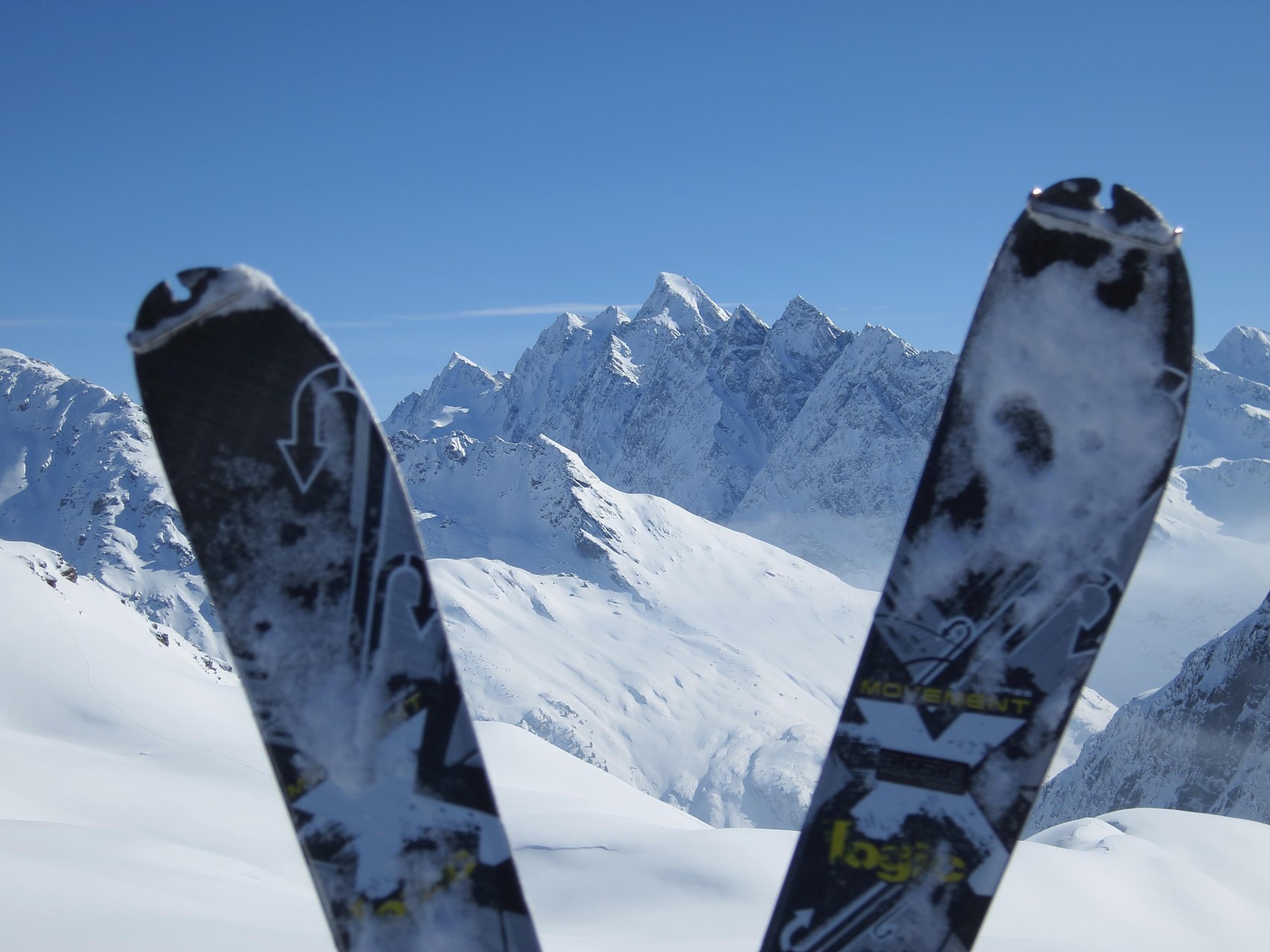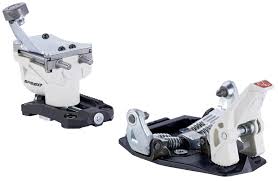
Movement Logic X skis with Verstanclahorn in the back (was one of the lightest skis a few years ago)
I am keenly interested in the “technical side” of the ski touring sport. Over the years I have accumulated quite a collection of skis, boots, bindings etc. From experience I can tell that the overall weight of your ski touring equipment really makes a difference. Here are a few general tips, if you want to “travel light”. Recently many wider and still very lights skis, as well as various Dynafit-type bindings and lighter boots have become available.
Weight Saving Summary:
- Skis weight saving 1kg (new lighter skis as compared to “traditional” touring skis)
- Pin-Bindings (Dynafit and many others available) 1kg or more (as compared to Fritschi bindings)
- Boots up to 1kg (make sure the boots fit and you can ski with them well)
- Backpack up to 0.5kg (on smaller tours a 0.5kg light backpack with 20l to 25l will do)
- Other equipment up to 0.5kg (light carbon poles and light clothing etc. easily add another 0.5kg of weight savings)
- Total weight savings up to 4kg
Note: Ski and boot weights differ significantly by ski length and boot sizes. Published ski weights usually are for 170cm to 175cm long skis. Boot weights are usually for size 27.5 (41).
If you want to save weight go for short skis (e.g. 10cm shorter than your height). Skins used on these skis are also lighter. Plus making switchback is easier as well.
Light vs. „normal“ ski touring equipment
The best ski touring equipment should be light, but still provide a lot of fun on the downhill in various conditions. A lighter ski touring set (skis, bindings, boots) weighs around 4 to 5 kg. A heavier set can easily reach 7-9 kg. You really can tell the 3-4 kg difference when going up hill! Further “weight saving” (ski poles etc.) can make also a difference.
(Dynafit-Type) Bindings
I can really recommend the Dynafit or Dynafit-type bindings (below 0.5kg to 1kg per pair). Other bindings such as the Diamir Eagle (1.8kg) are clearly heavier, not to speak of freeriding bindings (Marker etc.). So if you use one of the lighter Dynafit-type bindings, you save about 1 kg!
After Dynafit’s patent has run out, there are now quite a number of Dynafit-type bindings. The cheapest Dynafit (and one of the lighter) binding is the Dynafit Speed Turn at 780g per pair. These bindings (picture on the right) do not have stoppers, but use a cord clipped to the boots. Stoppers add about 300g per pair. If you do not like the turning back (I do), buy the newer Dynafit TLT Speed Radical.
Even Lighter Bindings
There are, of course, even lighter bindings such as the the Dynafit Speed Superlite 2.0 (which sells at about $/CHF 500k!) or e.g. the ATK Crest bindings (about the same price). Both bindings weigh less than 400g per pair! On some of the lightest bindings the heel piece cannot be adjusted backward or forward, so you can only use it with boots of the same sole lenghts.
Use of Dynafit Bindings
The Dynafit (and ATK) bindings have never (!) let me down and you can depend on them. Going uphill is also more comfortable. The only small draw back is that you need boots with Dynafit inserts (most of the boots offer that today anyway) and the bindings are not cheap, but have become more affordable. Also, some people (initially) have a hard time getting into the binding in powder or difficult terrain. But once you set used to them, it should not be a problem. Link to Dynafit homepage.
I forgot the mention one more advantage of the Dynafit-type bindings: the crampons – once attached – hardly slow you down and they are lighter too.
Skis
Skis have become lighter and wider (90mm or wider under the binding). Broader skis float better in powder and usually are easier to control in difficult snow conditions. More “classic” touring skis have about 85-88 mm width under the binding. They have a better grip on steep and icy slopes which can be important especially in spring or generally in “extreme” skiing. In good powder conditions classic touring also work fine, but wider skis provide the special “cruising feeling”.
Skis used to weigh around 3 kg up to 3.5 kg per pair. Quite a number of new fairly-wide skies have been introduced recently which pushed down the weight to below 2.5 kg per pair. As a general rule, light skis have less grip and are less fun on the downhill (and less safe on steep icy slopes). But newer models (such as the Blizzard Zero G85, or the Fischer Hannibal 94, both about 2.5kg per pair) perform much better in this respect than the older light “sticks”.
WildSnow, one of the best ski backcountry sites, povides many tests of recent touring skis.
Here is a pretty good guide to the various types of touring skis by Conrad Sport, a German online retailer (which sometimes offers great deal¨)
Ski Boots
Ski boots weigh about the same as touring skis (1kg per boot to 1.6kg or more per boot). So touring with lighter boots (if they fit and provide good downhill performance) can save up to 1kg in weight. As with skis, you can really tell the difference with lighter boots, as you have to push and lift skis and boots going uphill.
Light offerings are available from light boot pioneer Dynafit (such as the TLT series), Scarpa (such as the Scarpa F1) or Atomic Backland series. Light boots weigh between 1kg to 1.2kg per boot. There are many even lighter boots available, but these are used mainly for ski tour racing.
Other Equipment
Use light carbon poles: The lightest ones are one-piece without length adjustment. Use a light 20l to 25l backpack. Freeriding backpacks weigh 1kg or more. Light touring packs weigh about 500g to 600g. Clothing weight (especially outer layer) can also make difference. You can probably save another 300g there. Avalanche shovels come in various sizes and weights as well, but make sure you get a sturdy shovel. Avalanche safety is probably not the place where you want to comprise performance for weight. Only in long late-spring tours when conditions are really safe you might want to use a light (carbon) shovel.
